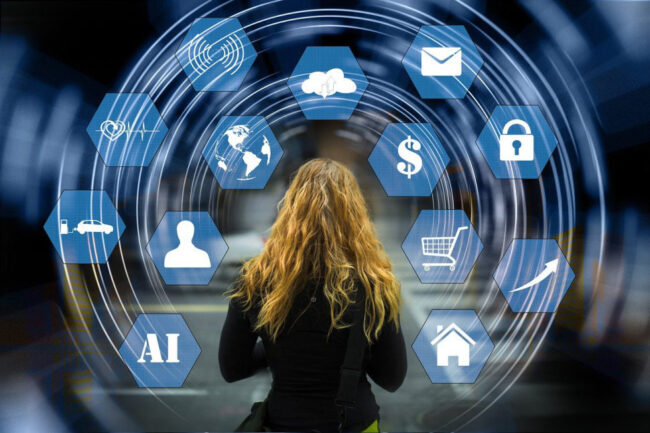
Artificial intelligence (AI) is a broad field of computer science concerned with the creation of intelligent machines capable of performing tasks that normally require human intelligence.
Artificial intelligence is the simulation of human intelligence processes by machines, particularly electronic systems (AI). Basic AI implementations include expert networks, natural language processing (NLP), voice recognition, and computer vision. This section of AI programming focuses on data collection and the development of guidelines for transforming data into relevant insights. The laws, known as algorithms, include step-by-step instructions for computing devices on how to complete a given task.
What Exactly Is Artificial Intelligence (AI)?
Artificial intelligence (AI) is a broad field of computer science concerned with the creation of intelligent machines capable of performing tasks that normally require human intelligence. AI is an interdisciplinary science with various approaches, but advances in machine learning and deep learning are causing a paradigm shift in nearly every field of technology.
Modern definitions of what it means to build knowledge are more precise. According to Francois Chollet, Google’s AI researcher and developer of the Keras machine learning software library, intelligence is related to a material’s ability to adapt and improve in a new context, to make assumptions about its knowledge, and apply it to unknown scenarios.
How Does Artificial Intelligence Work?
What Exactly Is Artificial Intelligence (AI)? How Does Artificial Intelligence Work?
Alan Turing changed history for the second time with a simple question less than a decade after cracking the Nazi encryption machine Enigma and helping the Allies win World War II: “Can machines think?” At its core, AI is a branch of computer science dedicated to solving the Turing difficulties. Machine intelligence is the attempt of machines to mimic or estimate human intelligence. The broad scope of artificial intelligence has raised a number of concerns and controversies. The main limitation of describing AI as essentially “creating intelligent machines” is that it does not adequately describe what artificial intelligence is. What causes machines to be intelligent?
Norvig and Russell then discuss four distinct approaches that have historically defined the AI field:
- Human-centred thinking
- Thinking logically
- Humane behaviour
- Reasonable behaviour
While everyone else is concerned with actions, the first two concepts are concerned with thought processes and logic. All of the abilities required for the Turing Test enabled an agent to act rationally.
While presenting to a crowd at the Japan AI Experience in 2017, DataRobot CEO Jeremy Achin began his speech by providing the following description of how AI is used today.
AI technology examples:
The Automation
When combined with AI technologies, automation software can expand the number and types of activities performed. Robotic process automation (RPA) is one example. RPA is a type of software that automates routine, rule-based data processing tasks that are typically performed by humans. When combined with machine learning and evolving AI tools, RPA will automate a larger portion of enterprise jobs, allowing RPA tactical bots to move AI information along and respond to process changes.
Robotics:
This area of engineering focuses on the design and manufacture of robotics. Robots are frequently used to perform tasks that are difficult for humans to execute or execute consistently. Robots are used in vehicle assembly lines, for example, and by NASA to move massive structures in space. Machine learning is now being used by researchers to create robots that can communicate in social environments.
Machine learning
Machine learning is a field of making a machine function without the use of code. Learning is a subfield of machine learning that can be thought of as the automated process of predictive modelling. There are three types of machine learning algorithms:
- Supervised learning Data sets are classified in such a way that it is simple to identify patterns and use them to identify new data sets.
- unsupervised Learning Data sets are not numbered and are sorted based on similarities or differences.
- Reinforcement Learning The data sets are not labelled, but the AI system receives feedback after performing an action or a series of actions.
Machine vision:
This invention gives the machine the ability to see. Computer vision collects and evaluates visual information using a camera, analogue-to-digital transfer, and digital signal processing. Computer vision is frequently compared to human vision, but it is not limited by biology and, for example, can be designed to see through walls. Is used in a wide range of applications, from fingerprint identification to medical image processing. Machine vision, which focuses on machine-based image recognition, is also conflated with computer vision.
Cars for self-driving:
Autonomous vehicles use a combination of machine vision, image recognition, and deep learning to develop automatic piloting skills when remaining in a given lane and avoiding unintended obstacles, such as humans.
Natural language processing:
Natural language processing is the processing of human words by a computer programme. One of the oldest and most well-known forms of NLP is spam identification, which examines the subject line and text of an email to determine whether it is spam. The foundation of new approaches to NLP is machine learning. NLP activities include text translation, emotion interpretation, and voice recognition.
How Does AI Work?
Narrow AI:
This type of artificial intelligence works within a limited context and is a simulation of human intelligence; it also focuses incredibly well on completing a single task, and while these machines may appear wise, they operate under far more constraints than even the most basic human intelligence.
Artificial General Intelligence (AGI):
The artificial intelligence processing we see in media, and films, such as Westworld robotics or Star Trek: The Next Generational Information, is often referred to as “Solid AI” AGI. AGI is a general intelligence system that, like humans, can use its intelligence to solve any problem.
Conclusion:
Machine intelligence is referred to as Artificial Intelligence. Artificial intelligence is becoming increasingly common in today’s world. It is the emulation of natural intelligence in computers that is designed to learn and imitate human behaviour. With practice, these computers can understand and perform human-like tasks.







